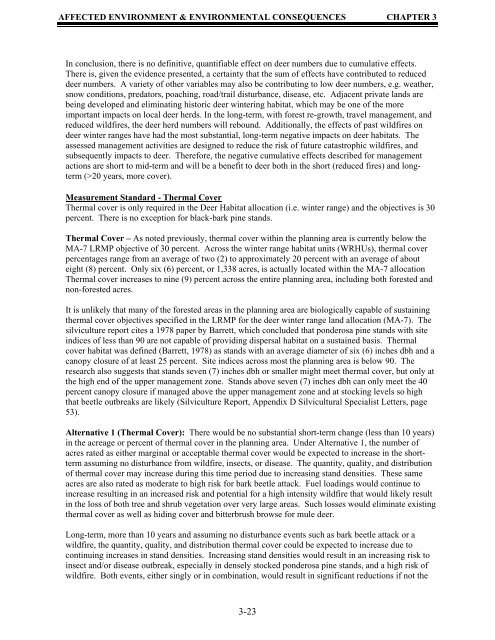Environmental Assessment
Environmental Assessment
Environmental Assessment
Create successful ePaper yourself
Turn your PDF publications into a flip-book with our unique Google optimized e-Paper software.
AFFECTED ENVIRONMENT & ENVIRONMENTAL CONSEQUENCES CHAPTER 3<br />
In conclusion, there is no definitive, quantifiable effect on deer numbers due to cumulative effects.<br />
There is, given the evidence presented, a certainty that the sum of effects have contributed to reduced<br />
deer numbers. A variety of other variables may also be contributing to low deer numbers, e.g. weather,<br />
snow conditions, predators, poaching, road/trail disturbance, disease, etc. Adjacent private lands are<br />
being developed and eliminating historic deer wintering habitat, which may be one of the more<br />
important impacts on local deer herds. In the long-term, with forest re-growth, travel management, and<br />
reduced wildfires, the deer herd numbers will rebound. Additionally, the effects of past wildfires on<br />
deer winter ranges have had the most substantial, long-term negative impacts on deer habitats. The<br />
assessed management activities are designed to reduce the risk of future catastrophic wildfires, and<br />
subsequently impacts to deer. Therefore, the negative cumulative effects described for management<br />
actions are short to mid-term and will be a benefit to deer both in the short (reduced fires) and longterm<br />
(>20 years, more cover).<br />
Measurement Standard - Thermal Cover<br />
Thermal cover is only required in the Deer Habitat allocation (i.e. winter range) and the objectives is 30<br />
percent. There is no exception for black-bark pine stands.<br />
Thermal Cover – As noted previously, thermal cover within the planning area is currently below the<br />
MA-7 LRMP objective of 30 percent. Across the winter range habitat units (WRHUs), thermal cover<br />
percentages range from an average of two (2) to approximately 20 percent with an average of about<br />
eight (8) percent. Only six (6) percent, or 1,338 acres, is actually located within the MA-7 allocation<br />
Thermal cover increases to nine (9) percent across the entire planning area, including both forested and<br />
non-forested acres.<br />
It is unlikely that many of the forested areas in the planning area are biologically capable of sustaining<br />
thermal cover objectives specified in the LRMP for the deer winter range land allocation (MA-7). The<br />
silviculture report cites a 1978 paper by Barrett, which concluded that ponderosa pine stands with site<br />
indices of less than 90 are not capable of providing dispersal habitat on a sustained basis. Thermal<br />
cover habitat was defined (Barrett, 1978) as stands with an average diameter of six (6) inches dbh and a<br />
canopy closure of at least 25 percent. Site indices across most the planning area is below 90. The<br />
research also suggests that stands seven (7) inches dbh or smaller might meet thermal cover, but only at<br />
the high end of the upper management zone. Stands above seven (7) inches dbh can only meet the 40<br />
percent canopy closure if managed above the upper management zone and at stocking levels so high<br />
that beetle outbreaks are likely (Silviculture Report, Appendix D Silvicultural Specialist Letters, page<br />
53).<br />
Alternative 1 (Thermal Cover): There would be no substantial short-term change (less than 10 years)<br />
in the acreage or percent of thermal cover in the planning area. Under Alternative 1, the number of<br />
acres rated as either marginal or acceptable thermal cover would be expected to increase in the shortterm<br />
assuming no disturbance from wildfire, insects, or disease. The quantity, quality, and distribution<br />
of thermal cover may increase during this time period due to increasing stand densities. These same<br />
acres are also rated as moderate to high risk for bark beetle attack. Fuel loadings would continue to<br />
increase resulting in an increased risk and potential for a high intensity wildfire that would likely result<br />
in the loss of both tree and shrub vegetation over very large areas. Such losses would eliminate existing<br />
thermal cover as well as hiding cover and bitterbrush browse for mule deer.<br />
Long-term, more than 10 years and assuming no disturbance events such as bark beetle attack or a<br />
wildfire, the quantity, quality, and distribution thermal cover could be expected to increase due to<br />
continuing increases in stand densities. Increasing stand densities would result in an increasing risk to<br />
insect and/or disease outbreak, especially in densely stocked ponderosa pine stands, and a high risk of<br />
wildfire. Both events, either singly or in combination, would result in significant reductions if not the<br />
3-23
















